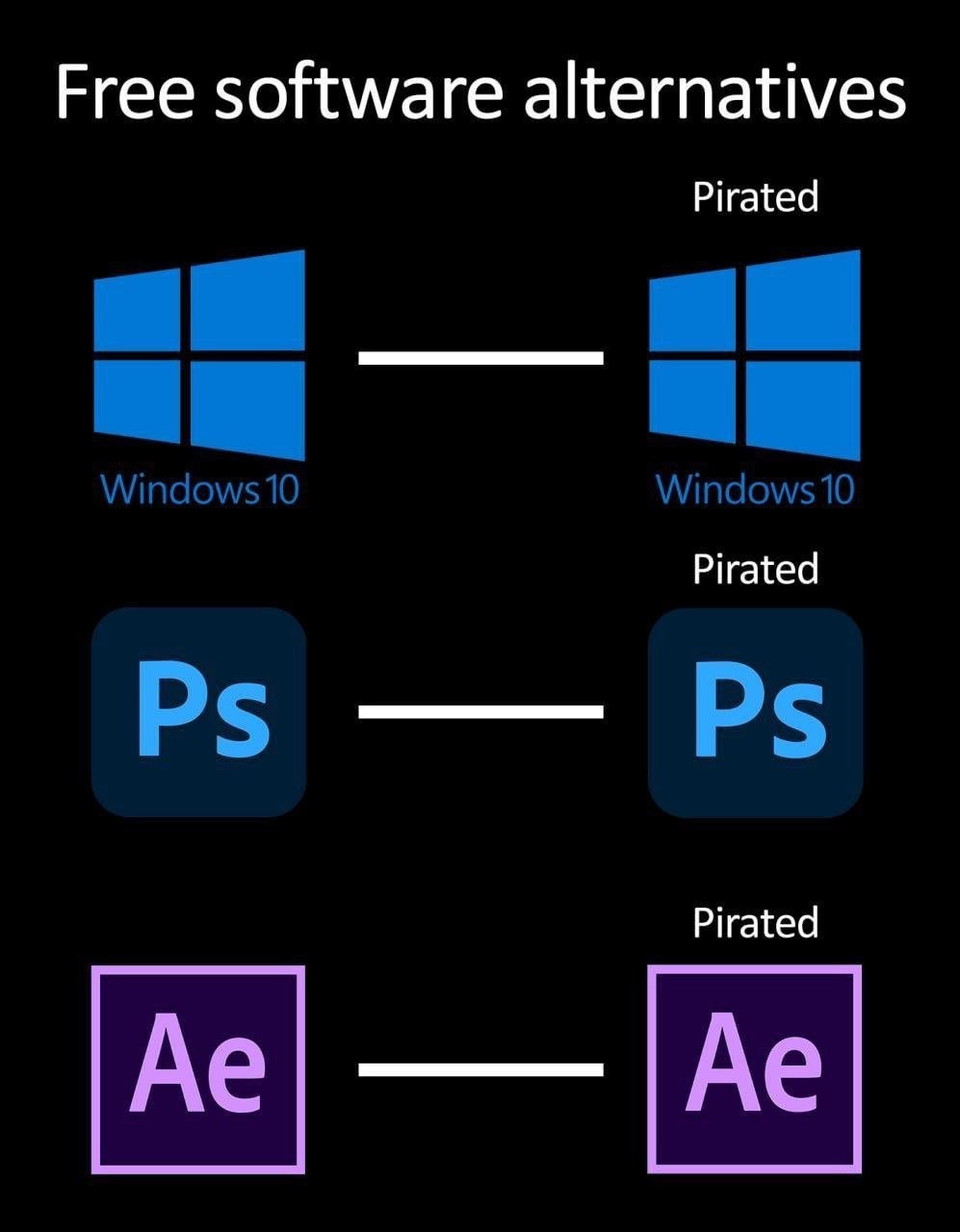
Gimp still isn’t an effective competitor
It needs gui rework from a UI designer and is still lacking in features that creatives use
Blender is amazing though
Krita is a great program for art but I wish they’d implement full vector functionality

I’m sure for anyone who has real work to do, GIMP will hold them back compared to Photoshop.
But I grew up using GIMP and got some pretty impressive results with it. Now that I have Adobe CC access and have been using Photoshop through that, I am perpetually confused on how to do x, which I know how to do in a couple clicks in GIMP.
To be fair, I’m sure that’d go doubly so for someone who started with Photoshop since it does have an objectively cleaner UI.

I’m the opposite. I grew up pirating CS4/5/6 Photoshop but just for simple tasks. I can’t for the life of me figure out Gimp.

I’ve used both and I miss features from each when using the other. Photoshop needs numeric entry for when positioning things.

Photoshop also lacks the automation features of the GIMP which makes it feel like a toy in comparison if your workflow usually involves performing the same repetitive actions on batches of images. Like, “how can anyone stand working with this‽ Everything is so manual!”

Oh cool, didn’t know that about GIMP! I’ve always wanted something more powerful than the Action Sequencer in Photoshop. What extra can you do in GIMP?

I’ve moved on to many paid, but not subscription apps mostly from independent shops. But I’m a designer using a Mac so your results may differ.
- Photoshop -> Pixelmator Pro (Affinity Photo is ok too)
- UX -> Sketch
- Illustrator -> Affinity Designer / Sketch
- Indesign -> … I hate when someone sends me a indesign file. I don’t do book, magazine, or catalog layouts anyway. PDFs are better and I can edit them in a bunch of apps.
I do still use Autodesk Fusion for 3D hobby projects, but I’m planning to switch to Ondsel (FreeBSD) over the winter.

I don’t understand why people say GIMP needs a UI rework. It seems vastly more intuitive than Blender’s UI 🤷
Don’t get me wrong: I love Blender–use it all the time for adding organic-like shapes to CAD stuff–but you can’t just sit someone down in front of the default cube and expect them to be able to get working. They’ll need a tutorial at the very least.
If you sit someone down in front of GIMP for the first time and ask them to perform common photo editing tasks they’ll have it figured out pretty quickly. Eventually they’ll get good at it. So much so that if you then take that person and put them in front of Photoshop they’ll be annoyed that they can’t follow their usually quick workflow.

Part of the problem is that 3d nodeling is unintutive in general imo. I have used both solidworks and blender and can say after learning both, they both have very steep curves (although solidworks has fun mesh rebuild errors to top everything off).

Yeah, I think you can argue for Krita, but it isn’t fully there for everything photoshop does.
I paid for Affinity Photo 2 and that does the trick for photo editing at a reasonable price. I really wish Gimp was up to it. Blender is really showing up most of the rest of that list, and of those Photoshop is where I think the biggest opportunity would be for a Blender-quality Gimp rework or alternative.

Reminds me of this:


Using pirated Adobe software these days is a much bigger pain in the ass than it was back in the day.

Those are free of price but they’re not free software (libre)

neither figma nor davinci is libre either

GIMP sucks and still has a horrid UI experience.

Gimp is an alternative to Photoshop the same way a bicycle is an alternative to a car.

/c/fuck_cars has entered the chat
/c/fuck_cars: YOU WOT
A sustainable alternative that keeps the user fit and enhances cities if adopted?

Yeah kinda. Its the right thing to do, but it feels weird when you start the conversion. It might not be as convenient, but it’s ultimately more versatile. Maybe you are not as fast as you used to be, but you have more control. There’s lots of facettes to this idea. I didn’t want to judge anything.

A superior one, got it.

krita

Unpopular opinion: Darktable sucks compared to Lightroom and I say this as someone who despises Adobe. There’s so many simple things that Lightroom gets right that Darktable completely fucks up and it drives me nuts. Just so painfully far from user friendly, intuitive design. For any serious photographer, it pains me to say this but Lightroom is worth that disgusting subscription fee.

Darktable can do things Lightroom has not even considered

I agree, but that doesn’t change the fact that Darktable is far from being as user friendly as LR.

Got an example? I like darktable, although figuring out which modules to use is definitely a bit of a learning curve

Something as simple as importing photos on Darktable is just such a pain in the ass compared to Lightroom.
In Lightroom, it automatically prompts you to import photos when a CD camera’s card is plugged in. You set the import location and it creates nested yearly, monthly and daily photos. When importing, the option to select only new photos is plainly in view. Once importing is done, LR automatically ejects the card.
Darktable, on the other hand… The whole import and then add to library method is just bizarre. Customization is great but when it just needlessly adds steps to the equation and disrupts what should be a butter smooth workflow, I jump ship. There’s so many things on LR I’ve been able to intuitively figure out while their Darktable equivalent require viewing tutorial after tutorial. It’s so annoying.

I don’t really share this experience to be honest, granted I copy my files to my pc manually anyways (I didn’t even know that your method was possible), but darktable has a feature pretty similar to that. “Copy & Import”, I don’t think it pops up automatically when you insert a card, but you can change the folder and the naming and such as you like. You can even ignore non-raw files, an option which I haven’t found in lightroom. So I’m not sure what’s so bizarre about the import tools in darktable, seems pretty similar to lightroom to me.
Customization is great but when it just needlessly adds steps to the equation and disrupts what should be a butter smooth workflow, I jump ship. There’s so many things on LR I’ve been able to intuitively figure out while their Darktable equivalent require viewing tutorial after tutorial.
That I kinda do agree with, some things in darktable are definitely more complicated than they should be, I don’t really want to watch a 40 minute tutorial on how to recover shadows from an image and there are also sliders and buttons which seemingly shouldn’t be used. So yeah darktable is less intuitive in that respect, although it works great ones you know what to do (And tbh it’s not that difficult, most tutorials are just excessively long)

lsdoesn’t paginate.
Most users don’t care about the features DT has over LR, that’s the point. If DT truly was the superior alternative, it would skyrocket in popularity like other open source software done right, like VLC.

I don’t know why downloading is your killer feature for a RAW development app. But when
lsscrolls too long I usemoreand when I need to download thousands of images a week to my NAS and working drive, I use Rapid Image Downloader. You can configure it to kick off automatically when you insert a drive. If that’s your major use case maybe you don’t need LT or DR.DR does what it does better than anything else. It’s not as good as other apps at what they do. That’s okay?

That’s not really a fair comparison. VLC development started in 1996. Darktable was first released in 2009. Give Darktable another 13 years of development and then you can make that comparison.

Except VLC 13 years ago is still far more user friendly than Darktable today.

I suspect they use a different definition of “Free” than we are used to. DaVinci Resolve and Figma are not FOSS, and have free and paid levels.
I believe the others are all free (as in beer) as well as free (as in speech).

Yup, I’d also say darktable + krita is a far better solution than gimp.
That said, for pro level stuff, resolve is much better than premier in general, so it’s a solid competitor from a “Linux support” category.

Yea, Shotcut should be there.

Was going to find this cause Shotcut fits right there against Premere and AfterEffect. Supports HDR editing(ie. you can extract clips off playstation 5’s HDR video recording) but not re-encoding and export as HDR.

As a former Photoshop user, I found all the paradigms and ways of thinking in Gimp were just so utterly different from what I was used to. Simple things like cropping, resizing selections and layer management felt like exercises in frustration.
Tried Krita instead, and I’m immediately feeling at home and able to be productive straight away.
I’m sure Gimp is awesome but my brain didn’t like it. If anyone else is feeling the same way, give Krita a try.

I’ve used both Gimp and Photoshop. I’m not super skilled in any of these, but Photoshop feels the most natural to use. I’ve never figured out a good workflow for Gimp.
It’s a shame, because functionality wise Gimp is quite competent. It’s just the UI that’s crap.

It is not just you. I started using gimp and later switched to Photoshop and it was such a great productivity improvement after just a few minutes.

Try Krita too then, if you’re interested in moving to free and open source. The paradigm is very similar to Photoshop.

As a former Photoshop user, I found all the paradigms and ways of thinking in Gimp were just so utterly different
The same is true when moving the other direction.
What most people find easier is the one they learned first.

This guide is misleading. Sure, the product functionalities overlap, but if you have a mature workflow, you will not be able to switch without investing a LOT of effort in relearning your workflow on the new product stack. This is one of my MAIN reasons I hate the “I tried to switch to Linux and failed” genre of content. You’re not going to find identical like-for-like replacements in Linux world that won’t require significant effort to relearn. It’s something us Linux users through and through need to bear in mind.
Also, we need to be cognisant that “just switching to Linux” narratives, fueled off infographics like this, will lead to frustration and dismissal.
No, I don’t know how to change this - and morphing e.g. gimp to be a clone of Photoshop isn’t the answer either.

Calling it a guide is misleading. It’s labeled as a list of alternatives and that’s what it is. Audio books are an alternative to reading, but it’s definitely not the same experience.

Hey now! The effort required to change workflows is how some of us have fun! Some of us derive joy in discovering new tools and new ways of doing things 😁
Think about it: How many people who switched to Linux at this point because they like learning new shit and fucking around? To them, a new tool that does something an old tool does in a new way is like being given a new flavor of ice cream to try! 🤣
It’s why old time Linux users “just don’t understand the resistance” people put up when it comes to changing apps… “WTF is your problem? If I can learn a new programming language in like two weeks surely you can learn the locations of a few new menu entries‽ I bet the new thing does stuff your old tool couldn’t do! If you just poke around you might be surprised…”
Normal people’s response: “Yeah… Fuck that. Spending that much effort to learn new things is what I call a waste of my time.”

This is such a classic Linux user response. Instead of taking the time to understand the many valid issues users have with Linux, you instead come to the same tired old smug conclusion that basically breaks down to "only smart people use Linux, like me!", and I say this as a Linux user.
Old time Linux users don’t understand why people avoid Linux because they’re not actually interested in listening and understanding peoples’ issues. Perhaps these people like learning lots of new stuff and spending hours troubleshooting, but just not with their computer. If there was a Linux equivalent of a car, it’s not hard to see why most people would just want the thing to work without bothering to become a mechanic for their car to work.
I’m sure there’s things you’ve avoided learning because you consider it to be a waste of time-- does that mean you’re unwilling to learn stuff, or would you agree that’s probably an inaccurate characterization of you? Most Linux users I’ve met are in terrible physical shape or mediocre at best. As someone in pretty decent shape, I appreciate the benefits and struggles of exercise but it’s just plain silly to basically shame others as lazy for the many reasons they could have for not exercising regularly.

I agree with your fundamental point, learning new shit is definitely fun for me. But there’s lots of different people and some just don’t. I can definitely sympathize with someone who’s income depends on one of these workflows, and why they can’t disrupt that for “fun learning sake”. There’s only so many hours in a day and some people have different priorities.

I don’t think pretty much anybody actually cares about their OS, they’ll just use whatever is installed on their computer and install their favourite applications.
There’s 2 things that need to be solved here:
- Having Linux installed on their computer.
To solve this we’d need mostly laptop manufacturers to install Linux by default, this is in no way happening soon, but might happen when point 2 is satisfied.
- Having peoples favourite applications available.
There’s 2 ways to solve this, A. Somehow get companies like Adobe on board with Linux and develop for it. B. Make open source applications actually good. We need people to want to use open source applications, before they even switch to Linux. That means the applications need to rival, or even surpass their closed source counterparts. Most of the Foss creative/professional applications simply don’t do that yet.
Solving these issues is not an easy task and will take a long long time, but most people simply will not want to switch to Linux and have to relearn every application at the same time, so I believe it is necessary

Your second point is key. In an ideal world, open source could rival and even beat the best paid offerings (see: blender). But in most cases it just doesn’t. There’s not a dedicated team working on the open source products, working with HCI experts and designers on every detail of the product. It doesn’t preclude the open source being better (see, again: blender), but it does push a LOT of workload onto a bunch of hobbyist developers working in their spare time. The resultant burnout is typically why you see these projects sputtering along for years and years. I don’t know how to solve those problems either, but they’re your real “roadblocks”.

I suppose it all comes down to money, Blender is an exception rather than the rule. They get a lot of donations from big companies, so they can afford to have a lot of people working on the project full-time. Most projects don’t have that luxury, so they get stuck like you said.
To be honest, I don’t know if there is a way to solve this, if there is it certainly isn’t easy

This is free as in free beer.

Krita for anything graphic design. Krita’s UI layout is a lot more similar to Photoshop than GIMP, which makes the switch easier.

Replace Figma with Penpot

Photopea would be a better drop in than Gimp. But it’s a website and that grinds my gears.

It loads completely in the browser. iirc you could disable your network after loading the “website” and it would continue to work. Simply a web app, if you will

Correct me if I am wrong but DaVinci Resolve is not really free software, right? It is just free to use proprietary software. Freemium or some such

Calling that Free Software was a bit of a poor choice by the author of this graphic

Yes it’s freemium, but it’s very usable for free. I’d estimate 95% of non professional users don’t care for the difference between free and paid. Also if you want to pay it’s a perpetual license for the current version, not a subscription like increasingly common.
It’s competitive with Adobe in terms of features and usability UX/UI, perhaps even better than Adobe in some parts.
It’s probably the best choice if you want to do video, movie maker and the like are to weak for your use case, and your not an ffmpeg magician. Because you can download it for free and get used to it quickly, and it can likely do everything you want for free. Except GPU rendering.

Figma balls XD

If I can’t do it in emacs, I do it in Blender.

Gimp is fucking trash

its not. but if you cant get used to the interface there is krita.

It is trash. Anyone who doesn’t understand why does not do graphic design professionally.

calling any Free software product trash is also ignoring the very point of the Free software movement. the developers donated their labor to benefit the end users and not to profit a company. I believe that this deserves a little more respect

It’s trash that has had a lot of hard work put into it by dedicated developers. Unfortunately, it’s still bad.

It’s being developed, the developers thus obviously use it. every Free software product has its use-case, even if it’s not suited for professionals.

Figma and blender are good the rest you’re better off with the paid

DaVinci Resolve is not exactly free but the affordable paid version is better than premiere in the eyes of many industry pros. It’s pretty unique in how it gives you a full post-production package in one software so you can seamlessly progress through the various parts of the project. The colour page has long been the top dog in that space and the rest is definitely serviceable though since I don’t use that heavily I can’t really confirm if fusion holds up against after effects, maybe you can combine that with blender and the other tool listed here as AE alternative.

It depends on the use cases. I don’t like how this post makes it look like the “Linux” alternatives are drop in, one-to-one replacement. Inkscape has been immensely useful to me, but for professional work, it might not be a reasonable replacement.
